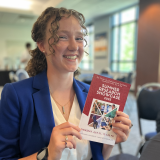Dance Science: Chapman Students Breaking Ground In This Up and Coming Field
October 5, 2011

Dance Science Student Monica Mordaunt
As the demands on dancers’ bodies increase with new choreographic and technical challenges, it becomes increasingly important that dancers are trained correctly and receive medical care with an understanding of what a human body can do. A dancer complaining of back pain has different issues than a businessman or a truck driver because the range of motion a dancer needs far exceeds what is typical for the normal human body. The field of dance science is addressing these issues of injury rehabilitation and is instrumental to changing the way young dancers are being trained. Making adjustments in the training of young dancers based on growth spurts, puberty, and body type may better prevent injuries and increase performance ability.
Chapman’s Department of Dance offers a dance science curriculum in which our students are doing groundbreaking research that is garnering national attention. In spring 2011, Department of Dance students Jacque Price (’11) and Beth Nicks (’11) had their study “Sleep patterns in collegiate dancers” cited in the March 2011 edition of Dancing Times, a national dance magazine published in the UK, in an article written by Rachel Rist titled “Dance Medicine at Birmingham”.
The studies “Dance teaching certifications: why teachers choose specific certification programs or none at all” by Jordan Krinke (’12) and “Changing the dance culture: educating collegiate dancers regarding benefits of effective warm-up and cool-down” by Monica Mordaunt (’12) were accepted to the International Association of Dance Medicine and Science (IADMS) conference in October 2011 in Washington, DC. IADMS was formed to enhance the health, well-being, training, and performance of dancers by cultivating educational, medical, and scientific excellence.
For the 29th annual Medical Problems of Performing Artists symposium of the Performing Arts Medicine Association (PAMA), held in July 2011 in Snowmass, CO, a study by Rena Nishijima (’12) titled “Genu varum and genu valgum among Asian dancers in comparison to non-Asian dancers” and a study by Whitney Kofford (’12) titled “A comparison of healthy eating knowledge and habits among college dance and music majors” were both selected for presentation. PAMA is an organization comprised of dedicated medical professionals, artists, educators, and administrators with the common goal of improving the health care of the performing artist.
All of these students have been mentored by assistant professor of dance Robin Kish, who was also accepted to IADMS to present both her study “Potential for noise induced hearing loss in dancers” and a study with Gary Galbraith, an MFA from Case Western Reserve and the Dancer Wellness Project, titled “A model for dance exposure data usage collected through an email based exposure tracking system”. She also participated in a panel discussion on the future of arts medicine at the PAMA conference. Professor Kish continued her mentoring work this summer by organizing a conference titled “Healthy Approaches in the Training of Dancers” in conjunction with PAMA at Chapman University during the month of August.

